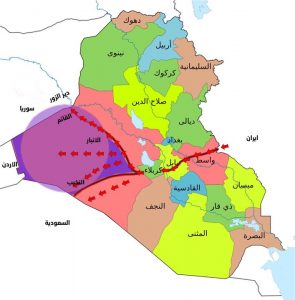After the administration of US President Donald Trump , in cooperation with its allies , Kurds of Syria, , has caused the failure of Iran’s plan to establish a land corridor stretching from Mosul through Kairouan and Ayadiyah down to Syria. Iran is still determined to build the corridor by any means , due to the importance of this corridor in the Iranian Strategic thinking . so Iran began to embark on the implementation of the “alternative corridor,” and according to private information obtained by Rawabet Center for Research and Strategic Studies , on 10 of the current September , a group of Iranian military advisers accompanied by leaders of the popular crowd and some of the officers in the Iraqi army close to them visited the area of “the Iraqi – Syrian-Jordanian triangle in addition to Nukhayib area adjacent to the borders of the Kingdom of Saudi Arabia. After previewing the border areas by scanning it by the drone aircrafts and the use of the Iranian Geophysical Technology , Iran has decided in cooperation with its allies to start the implementation of the “alternative corridor” on 16th of the current month, rather than at the end of it in order to make use of time .
This corridor with two tracks: the first starts from the Iranian border through the Iraqi cities of Kut , Karbala, Akashat , Ana and Abu Kamal down to the border triangle area. The second starts from the Iranian border, passing through the city of Kut and Karbala, leading to Nikhaib area in Anbar province, adjacent to the borders of the Kingdom of Saudi Arabia. To implement this corridor with its two paths , Iran and its allies will make a quick battles against Daesh and Syrian opposition. Indeed, according to Iranian- Iraqi-Syrian coordination , Iraqi army will not exceed the Iraqi border in the direction of Syria, and the matter of exceeding of these borders will be left to the militias of Iran when it needs .
If Iran was able to establish the alternative corridor on the ground, it would thereby isolate Iraq by land from neighboring Arab countries, and will maintain its interests in the region by retaining its ally Bashar al-Assad in Syria, and Iran will control the land corridors with those countries, and this will have very serious economic, political and security implications to those countries. The question that arises in this context: will the Arab states especially Saudi Arabia and the Hashemite Kingdom of Jordan, and their ally the United States allow the alternative corridor to become a reality? Data reports that the administration of US President Donald Trump will not allow it even it is forced to do an air landing in that region to cut off the road on Iran.
Because the US aims at some point after Daesh to curb the Iranian militias in the region, by preventing the meeting of the Syrian regime forces and the Iranian militias in Syria with their Iraqi counterparts, so it may resort to:
expedite the process of progress of the democratic forces of Syria “QSD” towards the Iraqi border east of the Euphrates to fill the vacuum that will be left by Daesh down to the Qaim area.
2-To strengthen the capacity of the clan crowd in Iraq concerned with the “liberalization” of Anbar from Daesh to protect its region, ensuring that the Iraqi militias do not cross from the border outlet of Qaim with Syria.
try to move the Syrian opposition factions to Shaddadi area ” Osoud Al-Sharqiya – commando of the revolution” to feed forces of “QSD” with Sunni Arab forces to be stationed east of the Euphrates and to reassure regional parties.
In light of the above, it looks the features of the outbreak of confrontation between Washington and its allies and Iran’s allies are possible by observers who interpret Washington’s position of being a too late move to address the military arms of Iran after it was earlier a strategy paper in the face of Daesh inside Iraq as a result of the insistence of the government of Abadi to give the popular crowd a political cover to legitimize its existence. And the premise of a military clash between Iran’s allies and US forces raises several possibilities , where some experts believe that Iran’s allies would suffer significant losses due to the lack of air cover and will have to pull back away from the border line, while others believe that these forces will stick to their positions fiercely, even though they are failed to progress inside Syria. Iran is planning beyond Syria, it is seeking through these militias which are carrying the sectarian banners and planted in Lebanon, Syria, Iraq and Yemen to hit Arab countries. Iran wants to establish a Persian empire by using sleeper cells in Syria as used in Iraq and in Yemen, Iran wants to open up corridors linking these countries by land to their lands for easy moving. So the conflict of control on the Iraqi-Syrian border serves as a puzzling chess game between a number of actors, and the militias backed by Iran are advancing in the direction of Iraq from the West, and the same Iranian leadership moves Iraqi militias in its direction from the east. There is a new and fierce battle can appear on the horizon. Observers believe that the issue of the international roads from and to Baghdad reflect the depth of the conflict that the region will witness after the elimination of Daesh and reflect the ongoing conflict about the future of the Iranian influence , not only in Iraq but in Syria and Lebanon and the region in general.
The Iraqi Studies Unit
Rawabet Center for Research and Strategic Studies

